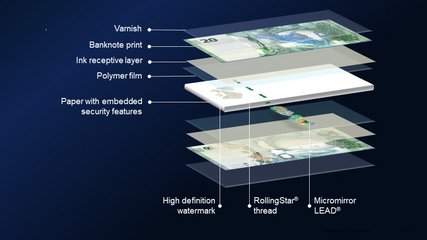

Banknote Security – Don't Take the Risk! Embedded Security Features are the Benchmark for the Overwhelming Majority of Banknotes
The technology platforms used for banknotes continues to rise ever higher, for all security levels – 1, 2 and 3. Challenging and beating the counterfeiter is central to the design, functionality and security of banknotes. And we note that with a well-defined security feature matrix to raise the bar, there can be success.
There are many properties which contribute to this success, pre-eminent among them being the multi-level substrate embedded platform for the design and integration of security in a modern banknote.
Case in point – the European Central Bank has recently announced a 17ppm counterfeit level. A historical low for such a popular regional and global currency and an all-time low for the ECB! The new €100 and €200 banknotes were the final notes issued in the Europa series in 2019, so 2020 was the first full year of reporting since the whole series has been in place.

What is it, specifically about embedded features, that works?
The real security value of banknotes is deep inside. There are many security and durability options for banknotes, in substrate, print and coatings. What is clear, however, is that the printed elements are more vulnerable to professional and casual attack by the counterfeiters than those in the substrate. It is much more challenging for the counterfeiter to have to replicate or mimic what is embedded deep in the substrate than what is on the surface.
When it comes to the influence of the substrate, those based on paper offer the decisive advantage of embedding the latest sophisticated security feature technologies, in particular the security thread, into substrate. Indeed, for paper-based substrates, these embedded features are a core security requirement, especially for higher denominations. It is for a very good reason that, according to the new report by Currency News on ‘Security Threads for Banknotes’, over 95% of all paperbased banknotes contain at least one security thread.
It is much more challenging for the counterfeiter to have to replicate or mimic what is embedded deep in the substrate than what is on the surface.
Clemens Berger, Managing Director, Louisenthal
And of course, the most widely known embedded security inherent in the paper, the watermark, in a range of multitone and highlight options to suit the banknote design, is still the most recognised and accepted security feature by most communities, as evidenced by several reports indicating which features the public are most familiar with.
Irrespective of the pros and cons of paper versus polymer substrates, the latter depend entirely on printed or applied security features in the form of optically variable inks or security foils and patches. Whether such features are on polymer or paper, they lack a key additional property that embedded features have – namely the ability to be viewed in transmission.
In the ‘Look, Feel, Tilt’ message, and variations of this, that many central banks use in public education campaigns these days, both the Look and the Tilt refer not only to the general appearance and optically variable effects, but also holding the note up to the light to see the embedded features.

Innovation can only go hand in hand with security
Of course, the ability to view other features in transmission is gaining traction, primarily through the window. With the introduction of polymer notes in 1988, the clear window was introduced to challenge the efforts of casual counterfeiters.
However, the mere presence of a clear window is not a secure feature in its own right – it’s what goes into or onto the window that counts.
The window has evolved over the decades and become adaptable for various substrates – with what started as an unprinted, clear portion of a banknote now offering dynamic design and colour shifts and ‘half windows’ of various forms, providing interesting and sophisticated security which integrates with other printed and foil features.
Whilst polymer has led the way in window development, the papermakers have caught up, and paper now offers the same advantages through apertures overlaid with foil or super wide threads.
And even, in our case, have gone a step further with our unique composite substrate Hybrid™, along with Hybrid ADDvance®, in which all the valuable security features, embedded and applied, are protected under a very thin polyester film.
Together these give level 1 security features a dramatic leap forward in visual and animation forms and help retain their properties in top condition in circulation. The security is fully scalable for both low and high denomination notes.
Critically, these substrates combine the best of both words – the additional durability provided by the protective polyester film with the traditional look and feel of paper, and its embedded and other security features, the presence of which plays a large role in public acceptance and (often intuitive) recognition.
When it comes to the influence of the substrate, those based on paper offer the decisive advantage of embedding the latest sophisticated security feature technologies.
Clemens Berger, Managing Director, Louisenthal
Factors to counterfeiting
Looking at security more generally, and which scores best – paper or polymer – all banknotes are subject to counterfeiting, irrespective of the substrate. The extent to which they are counterfeited is not only related to the security of the notes themselves (vital though this is), but also to the culture of criminality in a country, the enforcement regime, the risk/reward ratio related to the attractiveness of the note in purely financial terms and also – critically – the time lapse between the issue of a new note or series and the time it takes for counterfeiters to ‘catch up’.
Needless to say, a relatively small market does not attract the attention of counterfeiters in the same way that a large one does, and the larger the market becomes for polymer banknotes, the more attractive they become for counterfeiters. So the modern counterfeiter has caught up with plastic…
Whatever the substrate, new notes invariably result in a drop in counterfeiting – criminals will switch their attention to easier targets whilst they hone their skills to circle back to the upgraded notes. The fight is an ongoing one, with the issuers and their suppliers looking to stay one step ahead, and the criminals looking to catch them up.
There are several cases that highlight this. Mexico is one example. In 2011, the counterfeit rate skyrocketed for the polymer 50 peso. And because the counterfeits were indistinguishable from genuine notes, the Bank was unable to offer the public, the banks and retailers any information to help them authenticate notes. Only an upgrade and redesign of the note with optically variable magnetic inks could significantly reduce the rate again.
In Canada, the introduction of a new polymer series did reduce counterfeiting to begin with, but rates have been increasing in recent years, as reported annually by the Royal Canadian Mounted Police. Which doesn’t mean that the polymer notes are insecure, but does show that the old adage ‘if you can make it, they can fake it’ applies to all substrates. It’s just a matter of time.
And although Romania was the first European country to use polymer in 1999, there have been more recent instances of counterfeiting. We saw the headline Romania detains 'largest forger of plastic banknotes in the world'. And Europol cited: ‘the counterfeits were made on a polymer material and included all security features detectable by the public, making the identification of the fakes almost impossible for non-experts’.
But sometimes it doesn’t take long. In Trinidad and Tobago, soon after the introduction of new polymer notes, the police found bleached versions. As the ink is less anchored on polymer substrates compared to paper, counterfeiters tried to bleach the printed surface of low denominations in order to reprint them with a higher denominational value. This happens with paper-based notes as well, and the best defence is embedded features – threads and/or watermarks – specific to the denomination.
There are examples from other countries using polymer too. Which is not to say that polymer is more vulnerable to counterfeiting than paper – a determined counterfeiter will find a way irrespective of the substrate. But it does show that the assumption that a switch from paper to polymer will, on its own, remove counterfeiting is wrong.
The dual supply factor for polymer notes mitigates the risk to an extent, but, in reality, issuers have much greater choice from the more numerous paper, composite and security feature manufacturers to protect their banknotes against counterfeiting. The bigger the plastic banknote market
gets, the more attractive for counterfeiting it becomes.

Solutions don’t have to be disruptive
So plastic banknotes are not the fundamental solution for security – that solution lies in the features themselves. And, as above, we would argue that not only do embedded features provide the best security, but that such features work even better when harmonised with printed and applied features, in the so-called ‘synchronicity effect’.
What this means is that the imagery and other effects, such as colour shift, work even better when replicated or mirrored across multiple features. Hence the dynamism of the movement in a RollingStar® or Galaxy® windowed security thread matching the colour and movement of a SPARK® Live patch and even an applied feature such as LEAD stripe. Or the connection between a portrait in a thread with that in the watermark and in the intaglio.
There are so many ways in which the different elements can match or reference one another – but a centrepiece is the thread, or the watermark. Or even both.
Whilst there is much debate at the moment around the recent success of polymer (as summarised in an article in last month’s Currency News), in reality the volume of notes produced on polymer still remains at less than 5%, a proportion that hasn’t changed much over the past decade, even if the number of denominations on polymer has increased.
In other words, the vast majority of issuing authorities that continue to use paper for their banknotes can’t all be wrong!

The structure of a Hybrid composite substrate with security features.
Balancing durability with other factors
Polymer is without doubt more durable than cotton, and many lifecycle assessments have pointed to the reduced volumes that are needed with polymer notes (fewer raw materials and emissions from production), providing a key benefit over paper notes.
But many cotton-based options exist for enhanced durability. Substrate pre – and post – print coatings, inclusion of synthetic fibers, and minimal layers of plastics in a variety of composite banknotes provide a strong motivation to keep to a paper base with infused security.
We should also consider in the environmental debate the need for balance. It’s not just about durability – a note that lasts several years in circulation is of little value if the public won’t accept it, or the quality of the ink fails, or the security is compromised. The needs of public
engagement, security and durability need to be finely balanced.
But to go back to our main premise, which is the importance of embedded security. Here we feel that paper continues to be the best option. Enhanced durability and a lower environmental impact through raw materials, production, longevity and destruction are already built into today’s paper banknotes.
The environment and sustainability
And although the thrust of this article is to highlight the specific benefits of embedded security features in paper substrates, we cannot avoid the question of the environment, and sustainability.
The overuse of plastics and the abundance of plastic waste globally is a major concern. The polymer manufacturers are mitigating such concern by pointing to the recyclability of their product, which can be converted to household objects and building materials. But so, too, can cotton based substrates. Considering that millions of tonnes of wasted plastic products need to be recycled, the question is whether recycling of plastic is the optimal solution, especially when a natural cotton waste product is readily available?
The cotton-based substrates already use a ‘recycled’ short fibre fraction and therefore can be considered a naturally recycled product. Once polymer is finally incinerated CO2 is released into the atmosphere. Growing cotton is a carbon neutral process. We believe the cotton base is the optimal
environmental solution!
But security on all authentication levels is the mandatory prerequisite for confidence in cash, and in our view paper substrates are also in the best position to offer this.

Further Reading
Hybrid ADDvance® and Hybrid™
Hybrid ADDvance and Hybrid are Louisenthal’s solutions for durable and highly secure banknotes from low to high denominations.
Watermarks
Our three-dimensional, highlight and pixel watermarks can be used singly or combined – and we’re always working on new, advanced technologies that allow for a creative design. That results in higher protection and faster verification for everyone.
Galaxy® Security Threads
Clear authentication, high dynamics and 3D effects – Louisenthal has rolled all these properties into an innovative security thread technology. Galaxy is based on tiny microscopic mirrors plus ColourShift, a technology which provides a brilliant visual experience and extreme protection against counterfeiting.